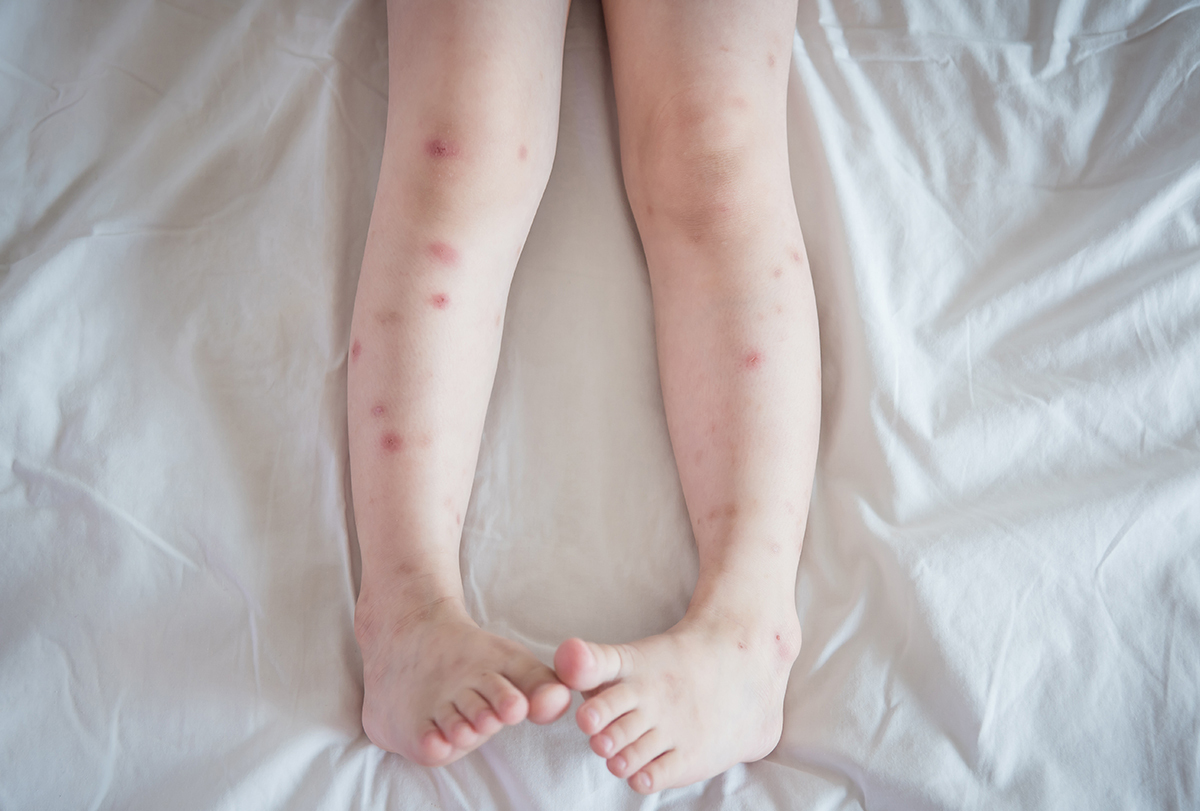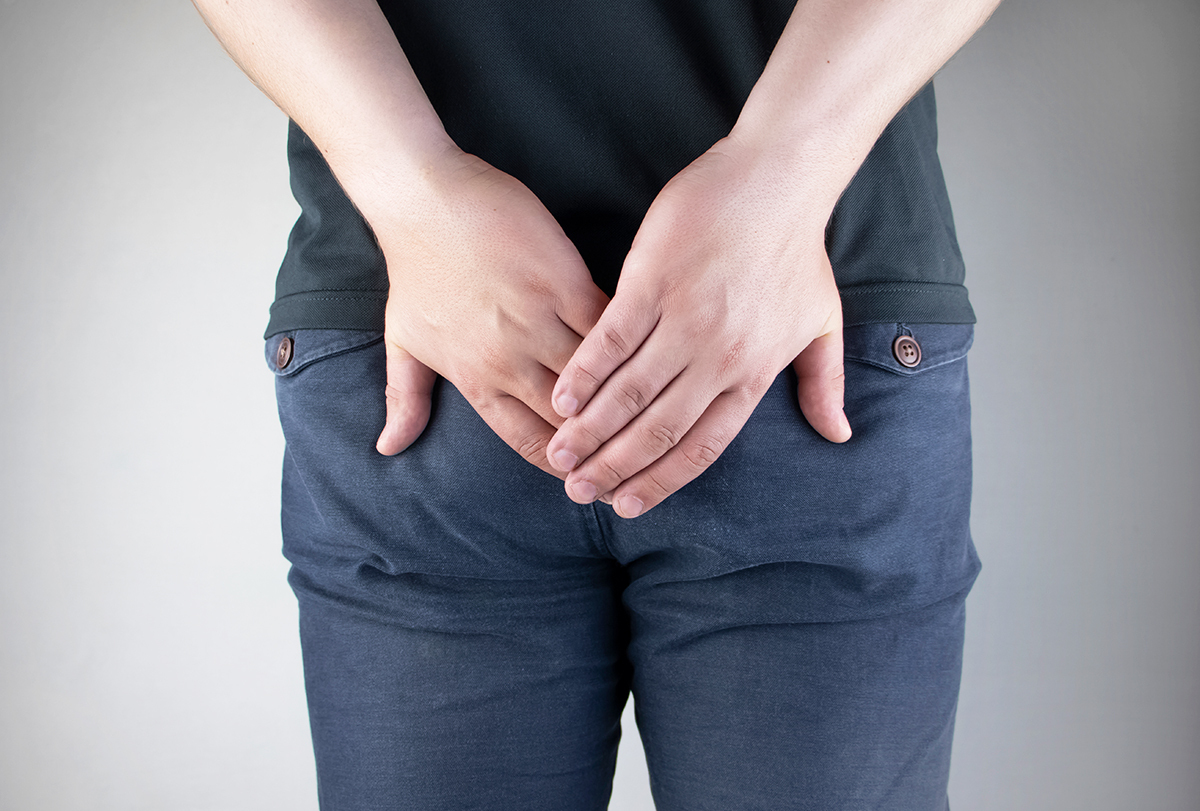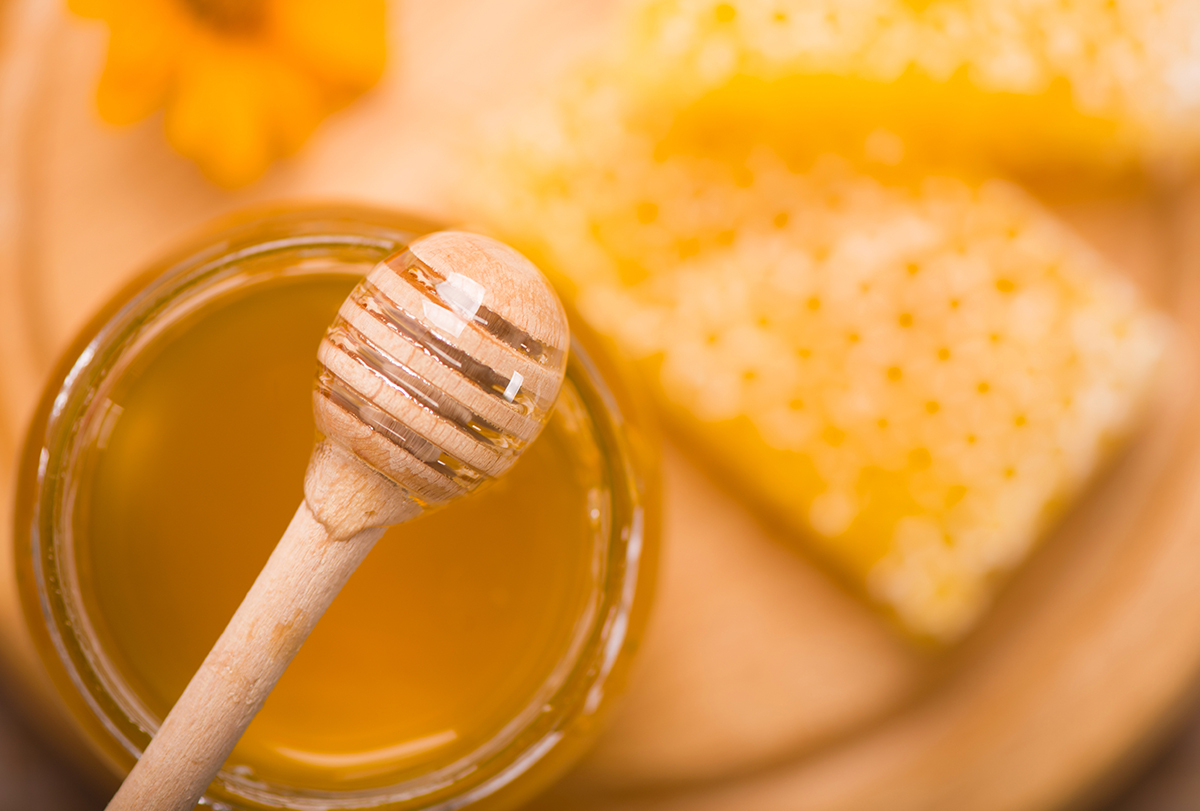
In this article:
Honey is recognized as a safe and natural skin healer on account of its strong antioxidant, antimicrobial, and anti-inflammatory properties.
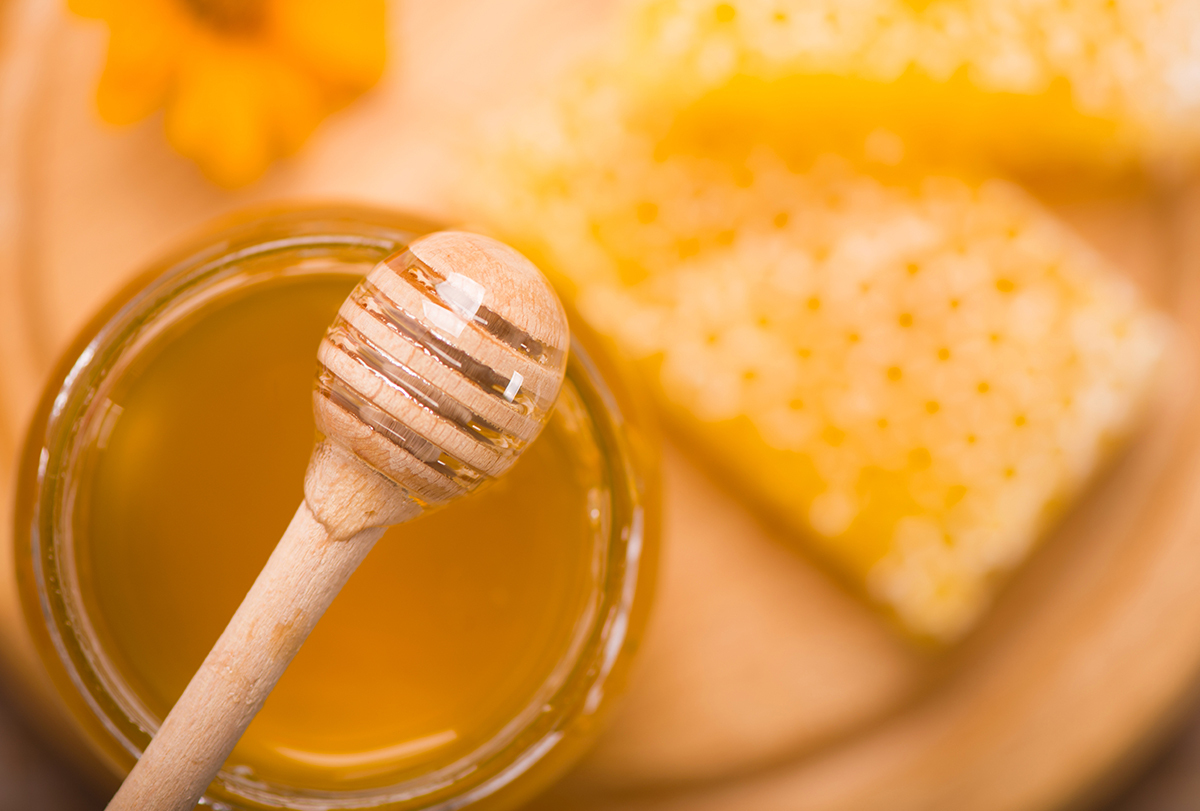
When applied to a wound, this viscous liquid forms a thick layer over the damaged skin to block out external irritants that can worsen the injury.
Plus, it works as a protective shield against germs that may infect the wound and prolong the healing process. Not just that, it helps bring down the inflammation and pain while accelerating skin repair.
Thus, it is no surprise that honey is often used as a dressing for different kinds of skin injuries such as leg ulcers, bed sores, burns, and cuts, and there is considerable scientific evidence to support its efficacy in this regard. (1)
googletag.cmd.push(function() { googletag.display(‘div-gpt-ad-1582735877778-0’); });
Honey to Treat Leg Ulcers

A leg ulcer is a type of open sore that takes a long time to heal, usually more than 2 weeks.
It is the result of poor blood circulation in the lower extremities caused by a variety of underlying conditions. In fact, it is the lack of blood flow that prevents the skin from healing quickly and properly.
You can typically find the ulcer on the inner side of the leg, right above the ankle.
In the beginning, the skin turns dark accompanied by pain, itching, swelling, and a feeling of heaviness in the affected area. The dry, irritated skin eventually breaks to form an asymmetric open wound.
There has been considerable research on the use of topical honey for healing leg ulcers, with some studies providing promising results but not without their limitations. (2)(3)(4)
Thus, more large-scale and rigorous clinical trials are needed to conclusively determine the true potential of honey as a dressing for leg ulcers. However, honey is unlikely to trigger any adverse side effects, making it worth a try.
googletag.cmd.push(function() { googletag.display(‘div-gpt-ad-1607514343973-0’); });
How to Use Honey for Leg Ulcers?
- Wash the affected skin with plain water to get rid of any superficial dirt and let it air-dry.
- Wash your hands with soap and water.
- Gently smear a little bit of honey over the ulcer with your fingertips. Use 100% organic honey, manuka honey, or medical-grade honey for this purpose.
- Leave it on for 10–15 minutes.
- Rinse it off with water.
Honey to Treat Bed Sores
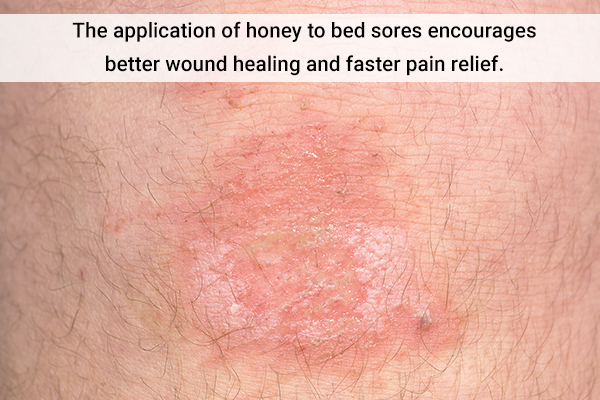
Bed sores develop when a part of the skin remains under constant pressure for a long period, causing damage to the skin and underlying tissue. This localized strain and trauma trigger inflammation in the area, which ultimately results in ulcer formation.
The ulcer starts off as a discolored patch that hurts, itches, and does not turn white when pressed upon. Over time, the underlying inflammation manifests in the form of a blister that may burst and turn into an open wound.
Bed sores mostly occur in people confined to beds or wheelchairs, but they can affect anyone.
One study showed that the application of honey to bed sores led to better wound healing and faster pain relief in 40 cancer patients under palliative care. (5)
Another review article showed that honey healed bed sores four times faster than any other topical ointment. It helped alleviate the associated pain and shrunk the wound size. (6)
How to Use Honey for Bed Sores?
- Mix some honey with regular sugar to make a thick paste.
- Gently apply this paste to the affected skin such that it fills the open sore.
- Use a thick gauze bandage to cover the wound.
- The fluid discharge from the sore will dilute the paste to make it runny after some time. When that happens, rinse the sore and reapply the remedy.
- Do this at least twice a day until the skin heals. (7)
Honey to Treat Burns
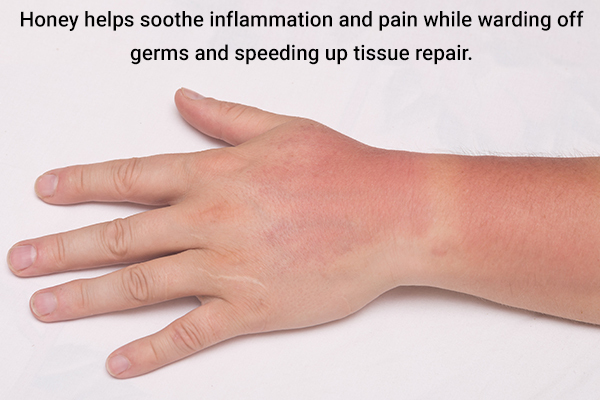
Honey has been used as a dressing for minor burns with good results. It helps soothe the inflammation and pain while warding off germs and speeding up tissue repair.
googletag.cmd.push(function() { googletag.display(‘div-gpt-ad-1595955311642-0’); });
A number of studies suggest that honey may be superior to other wound dressing options in this regard, but more extensive and rigorous research is needed to establish this claim. (8)(9)
How to Use Honey for Burns?
- When you get burnt, the heat gets trapped in the skin and keeps damaging the tissue. So, the first thing to do is to place the burnt area under running water to cool down the skin and cease the tissue damage. This will also help remove any dirt or debris present on the wound.
- Apply generous amounts of honey (preferably a ¼-inch-thick layer) over the burnt skin and the surrounding area. You can also soak a clean cotton pad in honey and then place it over the wound site to reduce leakage. (10)
- Cover the entire area with a clean bandage.
Honey to Treat Cuts and Wounds
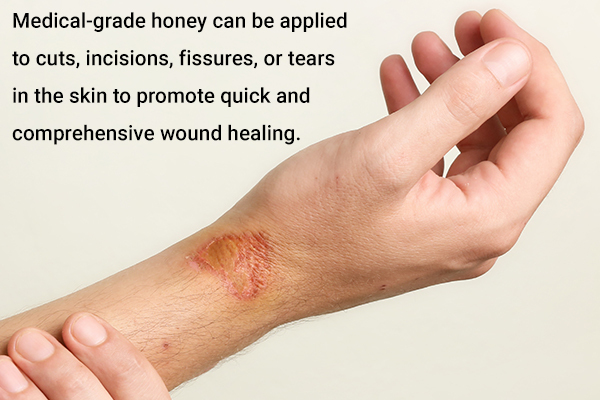
Medical-grade honey can be applied to cuts, incisions, fissures, or tears in the skin to promote quick and comprehensive wound healing.
Honey has been successfully used as a dressing for a variety of surgical and trauma wounds as demonstrated by a review study in 2021.
The antimicrobial properties of medical-grade honey work against a broad spectrum of bacteria with no resistant strains. Thus, it can help keep the wound from getting infected while it heals.
However, there is still a dearth of proper large-scale studies that examine the efficacy of honey for healing infected wounds. (11)
How to Use Honey in Cuts and Wounds?
- Spread generous amounts of honey on a cotton pad and place it on the wound.
- You can also apply the honey directly and then cover it with a clean gauze bandage. But in this case, the honey tends to become runny after mixing with the fluid oozing from the wound and causes a lot of mess. If that happens, you have to wash off the honey, and apply a fresh thick layer.
- You can also get honey-soaked dressing pads from a drugstore.
Final Word
The ancient Egyptians were the first ones to use honey for quick wound healing, but it is now gaining legitimacy in western medicine as well.
Honey provides a natural, inexpensive, and cheap alternative to regular dressing ointments. However, it’s best to consult your doctor before using it on deep, large, or infected wounds.
Manuka honey is particularly rich in antioxidants and other skin-healing nutrients, making it the best choice for topical application. But if it is not available, simple medical-grade honey works as well.
If you don’t find much improvement after a few days of honey application, it’s highly recommended to consult a dermatologist for proper treatment.



